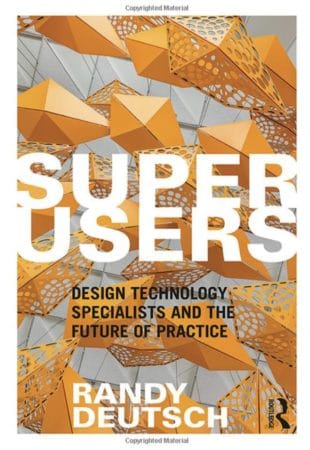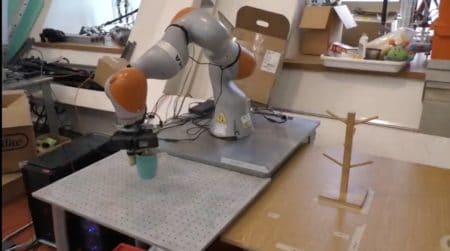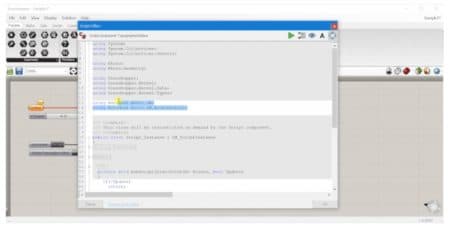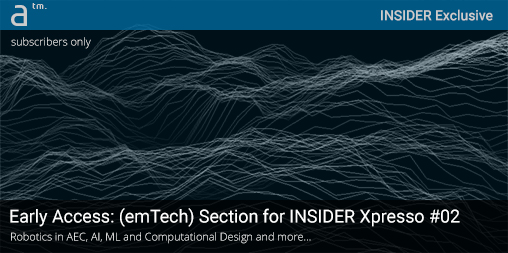WELCOME TO OUR EARLY ACCESS release of our emergent technologies (emTech) section of our monthly INSIDER Xpresso newsletter. We will be providing this new type of feature content right here on Architosh exclusively for our architosh INSIDER Members who have a yearly subscription plan.
Introduction—INSIDE Issue #02
Xpresso #02 will focus on VR and AR technologies at its center. The centerpiece of this content will be an in-depth feature on Visual Vocal’s new AR/VR technology—also to be released exclusively for INSIDER Members as an early access article.
Below you can find our complete emTech section for the upcoming Xpresso #02 newsletter—with more images than we put into our newsletter version. We even have some video below.
Let’s get started.
Computational Designers and Programmers: Two Fields, Similar Career Challenges
We start off a discussion of our curated content on Emerging Technologies by briefly discussing the similarities of “computational designers” in architecture as compared to professional programmers in the software industry—noting that they both present career paths that could be better characterized as “risk journies” than paths. In an article on Medium by A. Jesse Jiryu Davis titled, “Ctrl-Alt-Delete” The Planned Obsolescence of Old Coders,” we learn that coders (software programmers) over their 30’s face a perilous career future.
Similar Long-Term Career Challenges
Similarly, we learn in architect and professor Randy Deutsch’s latest book, “Superusers: Design Technology Specialists and the Future of Practice,” that these coding types—computational designer specialists—face a perilous career journey in the field of architecture as they age. “Computational designers, by not following the traditional path, take a lot of risks career-wise, and the professional trajectory becomes more of a risk journey rather than a career path.”

01 – Randy Deutsch’s book “SuperUsers: Design Technology Specialists and the Future of Practice” is a compelling read on multiple levels. One particular chapter deals with career path challenges for these new types of AEC professionals.
But this is where Davis’ article is important because unlike the architecture industry, the average age of workers in the software industry is strikingly different.
Big Age Differences
“The software industry is overwhelmingly young,” writes Davis. “The median age of Google and Amazon employees is 30, whereas the median age of American workers is 42.” According to Data USA, the median age of architects in the United States is 43.7. For the software programmer turning 40-years old, they face significant challenges across the industry, with expectations that they should matriculate to management roles. This contrasts with computational designers (architects who can code) in the field of architecture who don’t necessarily have clear senior-level career paths defined across the industry. Common to both computational designers and software programmers, as they age they must keep up with the highly evolving technology. Then there is the large-scale bias by age.
“In 2007, Mark Zuckerberg, then 22, said out loud what many in the software industry think: ‘Younger people are just smarter.’ ”
According to a 2018 research paper, skills [emphasis mine] change faster in science, technology, engineering, and mathematics (STEM) jobs…
But younger people in the field of architecture are definitely not thought of as just smarter as it relates to the core purposes of the profession. In the AEC industry, knowledge acquisition gained from project-based experience reduces risks for all types of AEC firms and their activities. In AEC, both knowledge and wisdom reign supreme. Davis writes, “According to a 2018 research paper, skills [emphasis mine] change faster in science, technology, engineering, and mathematics (STEM) jobs than in other industries, and the headlong rate of change for programmers is especially severe.”
Deutsch is an advocate that more STEM-based professionals, particularly programmers (coders), are going to populate the profession of architecture and that their contributions are critical to the profession’s evolution and perhaps survival. If this is the case—and much evidence suggests that it is—than perhaps both of these fields should learn from each other’s role-based problems.
In the case of architecture, those who can code and love to do so don’t have proven career paths within the field (and aren’t be pushed into management) but can be valued as computational designers and design technology specialists for decades if they want to be. Age bias in architecture isn’t functioning against older individuals (not yet), unlike in computer programming fields. The software industry is recognizing that some coders don’t want to enter management roles when they get past 35. “As an alternative to the management track, Google, Microsoft, and other large companies define an ‘individual contributor (IC) track,’ a ladder of job titles for senior engineers that rise in parallel to the management ladder.”
This is precisely the challenge confronting computational designers or design technologists in architecture. The AEC industry might learn by watching how the software industry is dealing with older computer programmers—finding the roles they can grow into as they progress through their career.
Robotics in AEC
The talk about robots in construction began in earnest many years ago but the action behind that talk is only now truly beginning to take off. There are many new and exciting companies beginning to produce in this space. One of those is New York-based Construction Robotics with its SAM100 masonry robot. SAM100 stands for Semi-Automated Mason and is the first commercially available bricklaying robot for onsite construction. It has the capacity to lay 380 bricks per hour, six times faster than a human bricklayer. The company also has a new MULE135 robot which is a Material Unit Life Enhancer. The device speeds up masonry construction as well by not necessarily building a masonry wall by itself but by taking away the strain on humans dealing with modular masonry unit work. Construction Robotics is robotics in construction company worth watching.

02 – TyBot by Advanced Construction Robotics is a large-scale robotic rebar tying machine that can work to rapidly tie together rebar in large slabs and decks common to infrastructure work and buildings.
Some robots for construction can be quite large. TyBot by Advanced Construction Robotics is a rebar tying robot that is ideal for large concrete pours like bridge deck work. It can autonomously tie rebar, working behind a human crew and doing up to 90 percent of all ties.
Robots can serve to address the severe skilled labor shortage in many advanced economies. In Japan, for example, one-third of all construction labors are over 57 years old, while the number under 30 years old is less than 10 percent, reports the BBC. Robots that save the hardship on bodies can enable older construction workers to stay active on the job, while the technology side of robotics can attract younger generation—particularly GenZ—into the construction field just at a key time when Baby Boomers are going to exit en masse.
5 Ways Robotics Will Disrupt the Construction Industry in 2019 is a good primer on where robotics in construction is headed this year. Also, the British arm of the multinational development and construction company, Skanska AB, is looking to build next-gen construction robots.
“As part of the initiative, Skanska UK PLC will lead the Flexible Robotic Assembly Modules for the Built Environment (FRAMBE) research consortium. The organization includes ABB Robotics, Building Research Establishment Ltd., Exelin Ltd., Tekla UK, and the University of Reading. FRAMBE will review potential robotic systems for tasks such as cutting and drilling on construction sites.”
Standard robots today face developmental challenges. From a research paper on a new approach to enabling 6-DOF (degrees of freedom) robotic arms to master movement and manipulation of objects, this research study titled kPAM—for KeyPoint Affordances for Category-Level Manipulation—offers what appears to be highly useful advances. In effect, a robot can better recognize an object type despite size and shape that it has never seen before. (eg: picking up a high-heel shoe when all it has seen and trained on are regular shoes).

03 – Researchers behind the kPAM studies have found a new method to teach a robot to correctly identify and manipulate objects that the robot has never seen before.
“Our pipeline is robust to large intra-category shape variation and topology changes as the key point representation ignores task-irrelevant geometric details. Extensive hardware experiments demonstrate our method can reliably accomplish tasks with never-before-seen objects in a category, such as placing shoes and mugs with significant shape variation into category level target configurations.” (watch the video here).
AI, ML, and Computational Design
Another story from Robotics Business Review, Japanese large heavy equipment manufacturer, Komatsu, has teamed up with NVIDIA to implement AI (artificial intelligence) on construction sites. The partnership will use NVIDIA GPUs to communicate with drones and cameras throughout the construction site to monitor for and prevent accidents.
Andrew Brust of ZDNet writes, “With a seemingly continuous emergence of machine learning and deep learning frameworks, and updates to them, as well as changes to tooling platforms, it’s no wonder that so much AI work is so ad hoc.” Welcome to the solution—Automated Machine Learning (AutoML for short). This is a movement, not a company or solution. It means a few companies are starting to execute in this direction, helping non-data scientists do simple AI and helping data scientists do complicated work even faster. Uber’s Ludwig platform is one example. The article has many more. Here’s another example of democratizing machine learning at OpenML, now in beta 2.
Quanta Magazine on How Artificial Intelligence is Changing Science. An excellent read on what scientists do that can and cannot be automated and how science disciplines themselves can change or are changing due to AI. This is a great read as it relates to Architecture. There is an example of the use of “generative adversarial networks” (GANs) creating fake people from other fake people (though one could simply start with real people). The matrix results are truly stunning—and shocking! But they point at what may be possible with GANs and the world of architecture—something Natasha Bajc from last month’s Xpresso newsletter is studying.

04 – A partial screenshot of Uber’s Ludwig platform that aims to democratize AI. Ludwig is a toolbox that allows to train and test deep learning models without the need to write code.
The man who helped invent virtual assistants thinks they are doomed without a new AI approach. This MIT Technology Review article is a great read. It implies that we need to train AIs more like human babies learn.
Author’s notes: Each month our emTech section will highlight content in the AI and ML space that takes us a step into the world of its use in AEC as well as backs out to the broader pictures forming and coalescing as this technology evolves and takes shape further within “market” and cultural realities. Japan is hard pressed more than any other country to deal with its declining population and shrinking labor force. It is not surprising to see big advances in AI and robotics in Japan’s construction industry. As industry players probe and explore AI and ML, it only makes sense that taking these tools into easier digestible formats will evolve. As we noted last month, AI and ML in CAD and BIM industries are in front of us. Larger market trends like AutoML will spill out into the bespoke computational space in AEC.
Earlier this week I had a fun conversation with Daniel Belcher of McNeel. We caught up on all things Rhino and Grasshopper. This weekend TT’s West Coast Hackathon takes places. The Rhino and Grasshopper code bases are being further democratized as well, through initiatives like compute.rhino3d.com and the RhinoInside movements. the RhinoInside technology is what has made it possible for GRAPHISOFT, for example, to build their bi-directional connections between their market innovative BIM solution and the world’s most popular AAD tool.

05 – RhinoInside is a developer tool that in essence allows other applications to host Rhino and Grasshopper.
RhinoInside allows both Rhino and Grasshopper to be embedded within other products. And Rhino 7 WIP can also now run inside other 64-bit Windows applications, like Revit, AutoCAD and potentially inside SolidWorks, Photoshop, and Excel.
ShapeDiver is a new discovery for us, thanks to Belcher.
Tidbits for the Salon
IBM unveils its first commercial quantum computer. The IBM Q system is a huge but beautiful system that combines into one package the quantum and classical computing parts. The 20-qubit system won’t ship on Amazon anytime soon but the system is truly available through partnerships with IBM. Here’s a tidbit: the glass enclosure of the system was designed by Goppion, the company that built the glass cases that house the UK’s crown jewels.
In more supercomputer type news, NVIDIA outbid both Intel and Microsoft to acquire Mellanox, a chipmaker for $6.9 billion. The buy strengthens NVIDIA in the world of high-performance computing.
Robots and AR clean up on new funding. This article looks at some of the companies grabbing the dough. One of those companies is Kaarta, a 3D mapping company that looks really interesting. Another company we already know is Markforged, Massachusetts-based leader in industrial 3D printing. It has closed an $82 million series D fund.
Can AI help cities identification gentrification before it is really happening? This Reuters story talks about finding hidden gentrification. Could be really useful for developers and market investors including individual buyers.
Exaflop computing. US DOE is paying $500 million for Aurora which will be built by Intel and Cray in 2021. But China already has three teams racing to build final working exaflop supercomputers. The US is behind already.
NVIDIA’s GauGAN AI tool offers a powerful new approach to creating physically real imagery.
GauGAN is an NVIDIA research project looking at generative adversarial networks (GANs)—already mentioned above and first discussed in last month’s Xpresso issue. The article reads:
GuaGAN could offer a powerful tool for creating virtual worlds to everyone from architects and urban planners to landscape architects and game developers. With an AI that understands how the real world looks, these professionals could better prototype ideas and make rapid changes to a synthetic scene.
Toyko 2020 Olympics will feature robots to help wheelchair users and workers.
Finally, something dear to Architosh readers—the next Mac Pro. Mac Pro 2019: Previewing the Possibilities explores just that and why it is exciting to think about what could be next for the next workstation from Apple.
emTech in INSIDER Xpresso #02
If you are an INSIDER Member reading this article and have not yet signed up for the INSIDER Xpresso newsletter, you can sign-up here for free. The monthly focuses on emerging technologies (emTech) and their impact on CAD and BIM-based industries and society as a whole.
INSIDER Members with annual subscriptions gain early access to Xpresso features.




Reader Comments
Comments for this story are closed